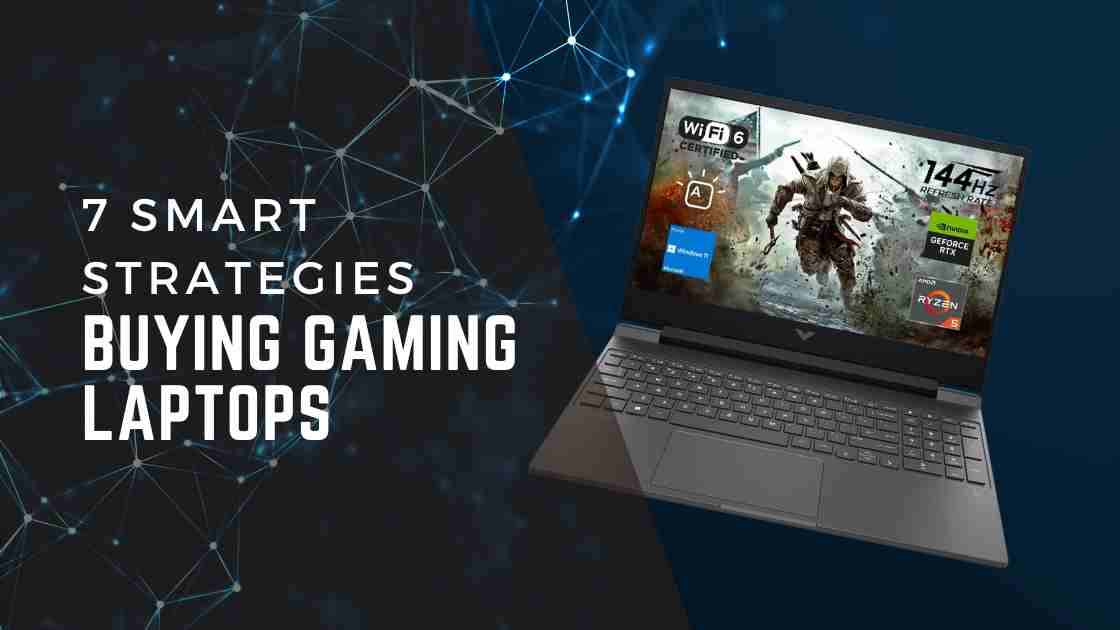7 Smart Strategies for Buying Gaming Laptops

Are you in the market for a new gaming laptop but overwhelmed by the plethora of options? Fear not, as we’ve compiled a comprehensive guide to help you make an informed decision. In this article, we’ll walk you through seven essential tips for buying gaming laptops that cover everything from budget considerations to hardware specs, ensuring you get the most out of your investment.
7 Tips for Buying Gaming Laptops
These are my top 7 tips for buying gaming laptops! Don’t you hate it when you spend money on things you don’t need? Well, this really applies to gaming laptops because they get so expensive, which is why my first tip is to determine your budget – how much are you willing to spend?
1- Budget Considerations
Entry-level gaming laptops start from around $500 or so, but they can easily exceed $5000 for a top-of-the-line model with all the bells and whistles – that’s 10 times the cost! Sometimes it is worth spending a bit more to get a better laptop. Especially if you’re going to use it daily for years. Honestly, the $1000 to $1400 price range is a great mid-range sweet spot for most people, as you get a nice balance of performance and features without going too crazy.
And you can actually save money on your next gaming laptop with our gaming laptop deals website, link below. We update it daily with the latest sales, so check it out regularly and don’t miss the savings!
2- Future-Proofing Considerations
Spending more money to get a “future proof” gaming laptop isn’t really a thing. Yeah, a more expensive laptop will usually run better, but after about $2000 or so you really start running into diminishing returns. So you end up spending way more money but it just doesn’t match the extra performance and features you end up getting.
Of course, it depends on the specs that you actually get inside. You don’t want to buy a gaming laptop only to find out that it can’t run what you had in mind. Which is why my 2nd tip is picking the right specs. Now there are 4 main components to consider here, and 2 of them cannot be upgraded, so it’s important that you make the right choice.
3- Choosing the Right Specs
The first is the GPU, or graphics. The GPU is what’s actually responsible for rendering the frames of your game, so a good GPU is critical for a good gaming experience. Ideally, you’d be looking at an RTX 4060 or 4070 as both of these have 8 gigs of VRAM. But the RTX 3070 Ti from last generation actually performs quite similarly to the 4070 while also being cheaper. But it is missing some features like DLSS 3 frame generation, which does make supported games run smoother.
And all three of these GPUs are around that $1000-$1400 price point that I mentioned earlier. But if your budget isn’t that big then RTX 4050 and RTX 3060 gaming laptops still do ok at 1080p gaming. But their 6 gigs of VRAM may become more of a limit in future games.
The second important hardware spec to consider is the CPU, or processor. While still important as it’s basically the brain of your laptop, it’s usually less critical compared to the GPU when it comes to gaming. But it does depend on the game, some games are more CPU heavy than GPU, and it also depends on the resolution. Generally, the CPU matters more at lower resolutions like 1080p.
But honestly, any modern i5 or i7 from Intel or Ryzen 5 or Ryzen 7 CPU from AMD in the last 1-3 year kind of range should run modern games perfectly fine. The third spec to consider is the RAM or memory. 8 gigabytes really isn’t enough anymore unless you’re looking for a cheaper entry-level experience. 16 gigs is still a good sweet spot based on our testing, but 32 gigs is nice if you can swing it. Especially if you run lots of stuff in the background.
And a 512 gig SSD is the minimum that I want to see these days. But even that can get filled up quite easily by just a small handful of AAA games. So again if budget permits, I think 1TB is much better. And ideally, the laptop has a 2nd M.2 slot available so you can just stick in another drive as needed.
In almost all gaming laptops, the CPU and GPU are soldered to the motherboard and cannot be upgraded, so definitely buy with those in mind first. You can always add more RAM and SSD space later, but you can’t upgrade the CPU and GPU. And along with costing more money, more powerful specs usually need a bigger laptop too.
4- Size and Weight Considerations
The biggest regret I’ve got when it comes to buying a laptop is buying too big. My first laptop was this crazy 17-inch chonker that I had to carry around school every day for 3 years. Of course, modern 17-inch laptops are much smaller than that, but the point is, I never had any bag space and I just regretted the purchase.
Which is why my third tip is around size and weight. There’s so much that depends on the size of your laptop, from how big your screen is, the size of your battery, how much space there is for cooling, how much space there is for upgrades, room for ports, the list seriously goes on. And I mean it makes sense, when you buy a laptop, ultimately you’re limited to what you can fit in this little rectangle. So a bigger rectangle means more things.
But unfortunately, it’s just not as simple as buying a bigger laptop to get all of those things, because a bigger size means more weight and less portability – it’s a tradeoff. A 14-inch laptop may not have as many features, but it’s easier to travel with and takes up less space in your bag. So if you need to take your laptop with you often, just have a think about how much bag space you’ve got and what it would feel like to put this extra weight on top of whatever else you need to take with you.
14, 15 and 16-inch gaming laptops are usually pretty good in terms of portability, while 17 and 18-inch screens are less portable, but fact is they do look nicer to play games on compared to a smaller screen. Personally for me, a great option is traveling with a 14-inch laptop but then connecting it to a larger 32-inch monitor when I’m home.
5- Screen Considerations
And this really leads us into our next tip, which is super important because it’s an area where most brands seem to cheap out on and cut costs first. Yet it’s what you actually spend all your time looking at when using the laptop, which is why tip number 4 is the screen.
Here are 5 things to consider when picking a gaming laptop screen. First, aim for at least 300 nits of brightness, closer to 500 ideally. Brighter is better. Go for at least a 144Hz refresh rate, again higher is better as it just makes things appear smoother. The lower the response time the better. Under 10ms is good, but over 20ms and games look really blurry. For colors try to get at least 90% of sRGB coverage for gaming and if you’re doing content creation then more than 90% DCI-P3 is good. For resolution 1080p looks alright for 14 and 15-inch screens, but consider 1440p especially at larger sizes and if you’ve got a good mid-range GPU. 4K gaming on a small screen is a GPU hungry luxury that’s not worth the money.
Alright bonus tip 4.5, RGB Lighting. The more RGB, the better your FPS in games… No, just checking if you’re paying attention.. Because the last thing you want is for your gaming laptop to turn off when you’re in the middle of important work. Which is why tip number 5 is about the battery. A larger battery has more juice than a smaller one, so get the biggest size you can.
Unfortunately, smaller laptops like those 14-inch models can’t fit the larger possible 99Wh batteries. So again this is another tradeoff that needs to be made based on the size of your laptop. Battery life also depends on the hardware inside the laptop. Gaming laptops with AMD Ryzen processors tend to last longer compared to Intel options. That’s not always the case, it depends on the specific machine, but it’s definitely a trend we’ve noticed after testing more than 200 laptops. So generally speaking, a bigger battery paired with an AMD processor will keep you running for longer.
6- Connectivity and Ports
Being able to connect more to your laptop will also help you get the most out of it. Some laptops just don’t have enough ports to connect what you need, which is why this is my 6th next tip. Bigger laptops usually have room for more ports, but that’s not always the case. You need to think about what sort of devices you plan on connecting. Do you need Ethernet network connectivity? What about an SD card slot? How many USB Type-A or Type-C ports? Do you want the Type-C port to be able to charge the laptop so you don’t have to take the bigger full-size charger around with you? How many monitors do you need to connect?
These are the sorts of things that only you know. So you need to have a think about what sort of devices you plan on connecting. You also need to think about where the ports are actually located. Is it going to be fine having ports on the sides where your mouse hand might go? Or would it be better to have them on the back with cables running out of the way? But then most laptops don’t have port icons on the back so if you actually want to plug something in and you’re sitting in front you can’t just look at it and plug in, you’ve got to turn the laptop around and that might be annoying.
Docks are a great way to add more ports with just a single cable going to your laptop.
Researching Detailed Reviews Before Buying Gaming Laptops
Alright, my 7th tip is quite simple but very important. Once you’ve got an idea of what you need and maybe narrowed your search down to a few different laptops you really need to check out detailed reviews like the ones we post on this channel. So make sure you’re subscribed for those! Every gaming laptop is unique and behaves differently, even if they have the same specs on paper. It’s important to do your research before spending your hard-earned money.
Now while these tips are a great start, they’re just the basics. There’s a lot more you need to know about before buying your next gaming laptop, so check out this one next to dive into all the details! I cover pretty much everything to help you avoid making critical mistakes, so I’ll see you in that one next.
You May Also Like to Read: The Ultimate Guide to the Top 10 Best Laptops of 2023







